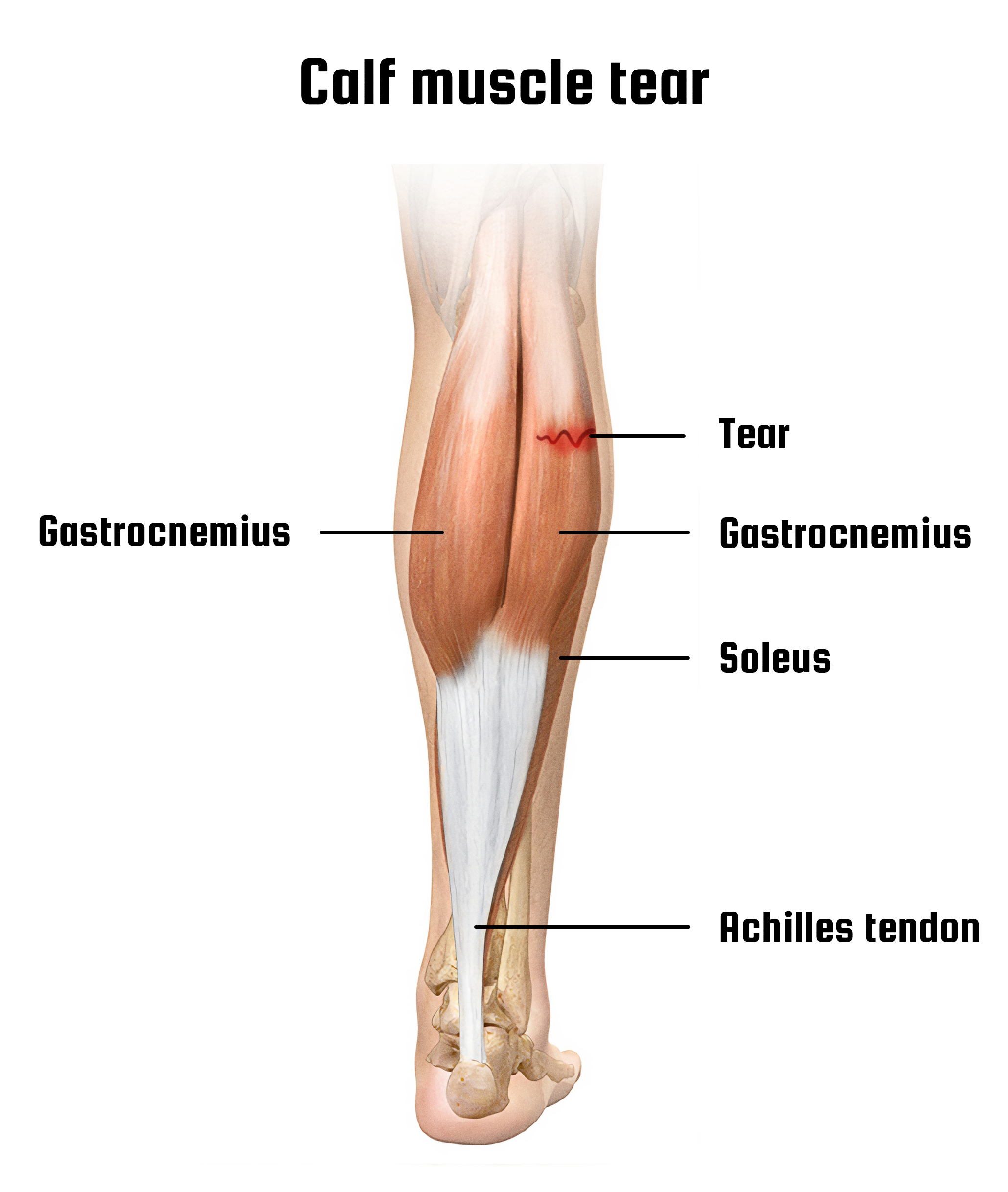Gastrocnemius Tear: Calf muscle Tear and Soleus Muscle Strain
The gastrocnemius or the chief muscle of the calf is a powerful calf muscle that generates jumping and sprinting movements. A Calf Strain or pulled calf muscle generally involves the medial gastrocnemius muscle and often includes a soleus muscle strain. A Gastrocnemius muscle tear generally occurs when the calf muscles become overstretched, and the strain exceeds the gastrocnemius’s ability to be lengthened. Medial gastrocnemius muscle strain is the most common torn calf muscle, but during severe sports injuries, a gastrocnemius rupture or Achilles tendon rupture can occur.

Causes of Injuries or Tears
The gastrocnemius muscle is the primary propulsion mechanism of the lower leg, ankle, and foot during running and jumping. Gastrocnemius muscle strains occur when the calf muscles including the soleus become overstretched and muscle tearing occurs, usually during a push-off during running or jumping. This can be micro-tearing, or complete in the case of a gastrocnemius rupture.
- Grade 1: Gastrocnemius tear (5% or less)
- Grade 2: Moderate Gastrocnemius tear (10-90%)
- Grade 3- complete gastrocnemius rupture
The medial gastrocnemius is most commonly torn, and calf strains often include injuries to the soleus muscle and Achilles tendon.
Symptoms
The term pulled calf gets the name of the sudden pain in the gastrocnemius that occurs during push-off maneuvers. The sudden calf pain is very specific and can include the following symptoms:
- Popping sensation or noise followed by immediate gastrocnemius muscle pain
- Calf pain during pushing off indicating a Gastrocnemius tear
- Calf muscle strength loss (Grade 2 and 3)
Treatment
A Torn calf muscle, gastrocnemius tear, or calf strain including medial Gastrocnemius strain (MGS) generally responds well to conservative care (grades 1 and 2).
Non-operative treatments of a gastrocnemius tear should include:
- Rest- 3-4 weeks of (complete or relative) depending on the grade of calf muscle strain
- Heel lifts- first few weeks to lessen pain
- Compressive sleeve- reduce swelling
- Ankle and foot Mechanical dysfunctions- Dorsiflexion limitation, big toe extension limitation (likely cause of gastrocnemius tear)
- Sural Nerve- Manual mobilization and stretching to reduce pain
- Strengthening Exercises- medial and lateral heads of Gastrocnemius, soleus, peroneal longus, and tibialis posterior
- Proprioceptive Exercises- Foot and Ankle
Surgical Treatment
A Gastrocnemius tear generally doesn’t require surgery, but if the Achilles tendon is involved then surgery may be required. Expert resource for more information.
Recovery
A Gastrocnemius tear depends on the severity of the muscle strain. Return to play can take just a few weeks up to 3-4 months depending on the severity of the strain or tear.
Recovery time:
- Grade 1 Gastrocnemius tear- 2-3 weeks
- Grade 2 Gastrocnemius tear 3-6 weeks
- Grade 3 Gastrocnemius tear up to 3-4 months
If a patient experiencing a calf muscle strain or gastrocnemius tear takes the required rest period, addresses the causative biomechanical dysfunctions, and guided rehabilitation program then a chance of recovery from a gastrocnemius tear are very favorable.
Our editorial practices include evidence-based practices, interventions, and recommendations.
GET IN TOUCH WITH DR. DEAN
YOU should be able to move the way you’d like to move without experiencing pain. YOU should be able to experience freedom and energy knowing there’s nothing holding back from giving your life 110%. Dr. Dean would like to learn more about your challenges with a quick phone or email before beginning treatment. Contact him today.
